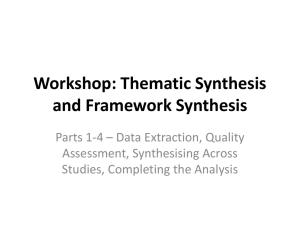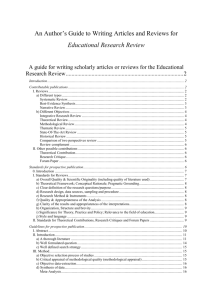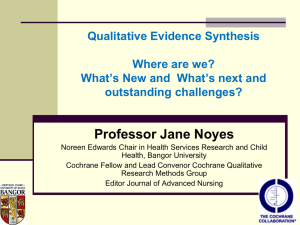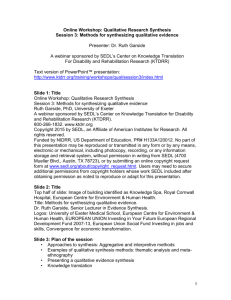Table 3. Summary of characteristics of papers included in the review
advertisement
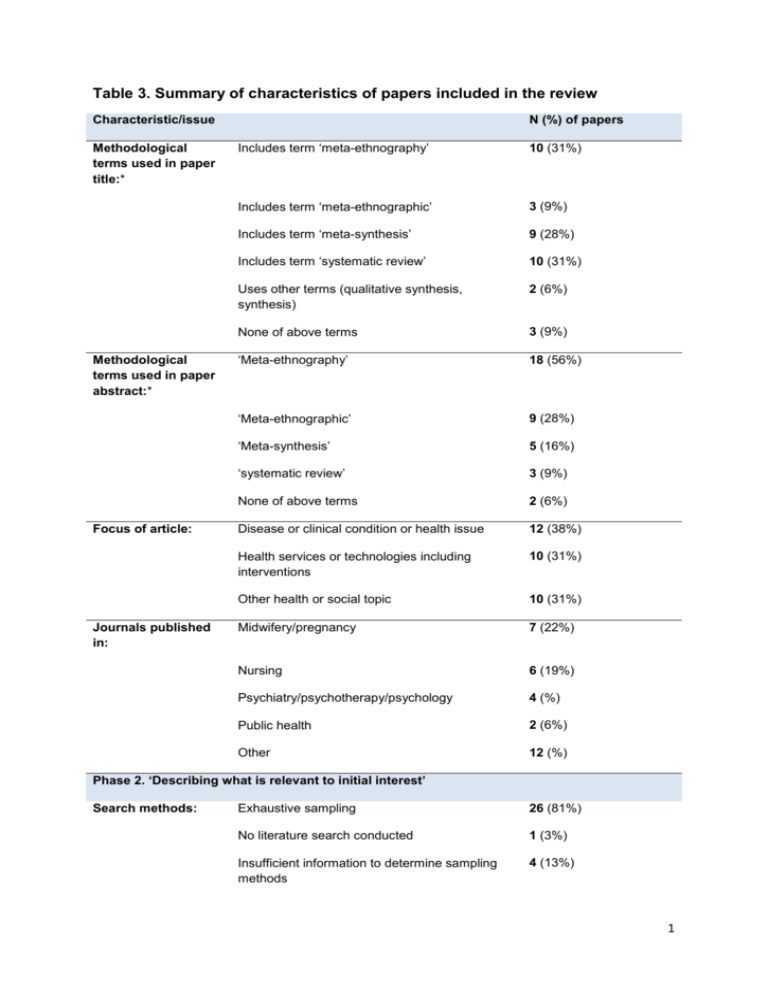
Table 3. Summary of characteristics of papers included in the review Characteristic/issue Methodological terms used in paper title:* Methodological terms used in paper abstract:* Focus of article: Journals published in: N (%) of papers Includes term ‘meta-ethnography’ 10 (31%) Includes term ‘meta-ethnographic’ 3 (9%) Includes term ‘meta-synthesis’ 9 (28%) Includes term ‘systematic review’ 10 (31%) Uses other terms (qualitative synthesis, synthesis) 2 (6%) None of above terms 3 (9%) ‘Meta-ethnography’ 18 (56%) ‘Meta-ethnographic’ 9 (28%) ‘Meta-synthesis’ 5 (16%) ‘systematic review’ 3 (9%) None of above terms 2 (6%) Disease or clinical condition or health issue 12 (38%) Health services or technologies including interventions 10 (31%) Other health or social topic 10 (31%) Midwifery/pregnancy 7 (22%) Nursing 6 (19%) Psychiatry/psychotherapy/psychology 4 (%) Public health 2 (6%) Other 12 (%) Phase 2. ‘Describing what is relevant to initial interest’ Search methods: Exhaustive sampling 26 (81%) No literature search conducted 1 (3%) Insufficient information to determine sampling methods 4 (13%) 1 Characteristic/issue Search methods: Critical appraisal: Quality of analysis and reporting: N (%) of papers Comprehensive date range 8 (25%) Date range not stated 4 (13%) Gave clear description of databases used 24 (78%) Used supplementary search strategies 21 (66%) Gave clear description of key words/search terms 21 (66%) Number of included studies Range 3-60, mean=20, median=18 Number of included papers Range 3-77, mean=21, median=18 Used a method of critical appraisal 26 (81%) CASP method 12 (38%)* COREQ method 2 (6%)* JBI QARI method 2 (6%)* Other method of critical appraisal 12 (38%)* Clearly described Noblit and Hare’s analytic phases of meta-ethnography (with more than just the labels) 11 (34%) Clearly recognisable as meta-ethnography 11 (34%) Not recognisable as meta-ethnography 14 (44%) Unclear from information provided whether synthesis was a meta-ethnography 7 (22%) Phase 3. ‘Reading the studies’ Stated order in which papers were read/synthesised 5 (16%) Clearly described how concepts/metaphors were identified 23 (72%) Reported total number of second order constructs 9 (28%) 2 Characteristic/issue N (%) of papers Phase 4. ‘Determining how studies are related’ Stated that they carried out phase 4Determining how the studies are related 26 (81%) clearly described how they did determined how the studies are related 21 (66%) Phase 5. ‘Translating the studies into one another’ Clearly described reciprocal/refutational translation process 10 (31%) Phase 6. ‘Synthesizing translations’ Number of researchers carrying out analysis Authors’ conflict of interest/competing interests Clearly described how concepts/translations were synthesised 1 (3%) Clearly described which papers contributed to new interpretations 14 (44%) Claimed to present third order constructs (even if labelled differently) 15 (47%) Claimed to present a line-of-argument synthesis 17 (53%) Claimed to present a new conceptual model or theory 10 (31%) Presented a new interpretation 13 (41%) Did not present new interpretation 7 (22%) Unclear from information given if presented new interpretation 12 (38%) Not stated / not clear 9 (28%) 1 5 (16%) 2 6 (19%) 3+ 12 (38%) States no conflict of interest 21 (66%) States conflict of interest 1 (3%) Not stated 11 (34%) 3 Characteristic/issue N (%) of papers Phase 7 – ‘Expressing the synthesis’ Written format of findings only 16 (50%) Key methodology texts cited:* Written and visual representations of findings 16 (50%) Present participant quotes from primary studies in findings 26 (81%) Present quotes from the authors of primary studies in findings 1 (3%) Noblit, G. W., & Hare, R. D. (1988). Meta– Ethnography: Synthesizing Qualitative Studies (1988). Stage, Newbury Park, CA. Britten, N., Campbell, R., Pope, C., Donovan, J., Morgan, M., & Pill, R. (2002). Using meta ethnography to synthesise qualitative research: a worked example. Journal of Health Services Research & Policy, 7(4), 209-215. 32 (100%) Campbell, R., Pound, P., Pope, C., Britten, N., Pill, R., Morgan, M., & Donovan, J. (2003). Evaluating meta-ethnography: a synthesis of qualitative research on lay experiences of diabetes and diabetes care. Social science & medicine, 56(4), 671-684. 10 (31%) Campbell, R., Pound, P., Morgan, M., DakerWhite, G., Britten, N., Pill, R.,Yardley, L., Pope, C. & Donovan, J. (2011). Evaluating meta ethnography: systematic analysis and synthesis of qualitative research. Health Technology Assessment, 15(43). 7 (22%) Atkins, S., Lewin, S., Smith, H., Engel, M., Fretheim, A., & Volmink, J. (2008). Conducting a meta-ethnography of qualitative literature: lessons learnt. BMC medical research methodology, 8(1), 21. 8 (25%) Malpass et al 2009 Malpass, A., Shaw, A., Sharp, D., Walter, F., Feder, G., Ridd, M., & Kessler, D. (2009). “Medication career” or “Moral career”? The two sides of managing antidepressants: A meta-ethnography of patients' experience of antidepressants. Social science & medicine, 68(1), 154-168. 7 (22%) 10 (31%) *Some papers are counted in more than one category. 4




